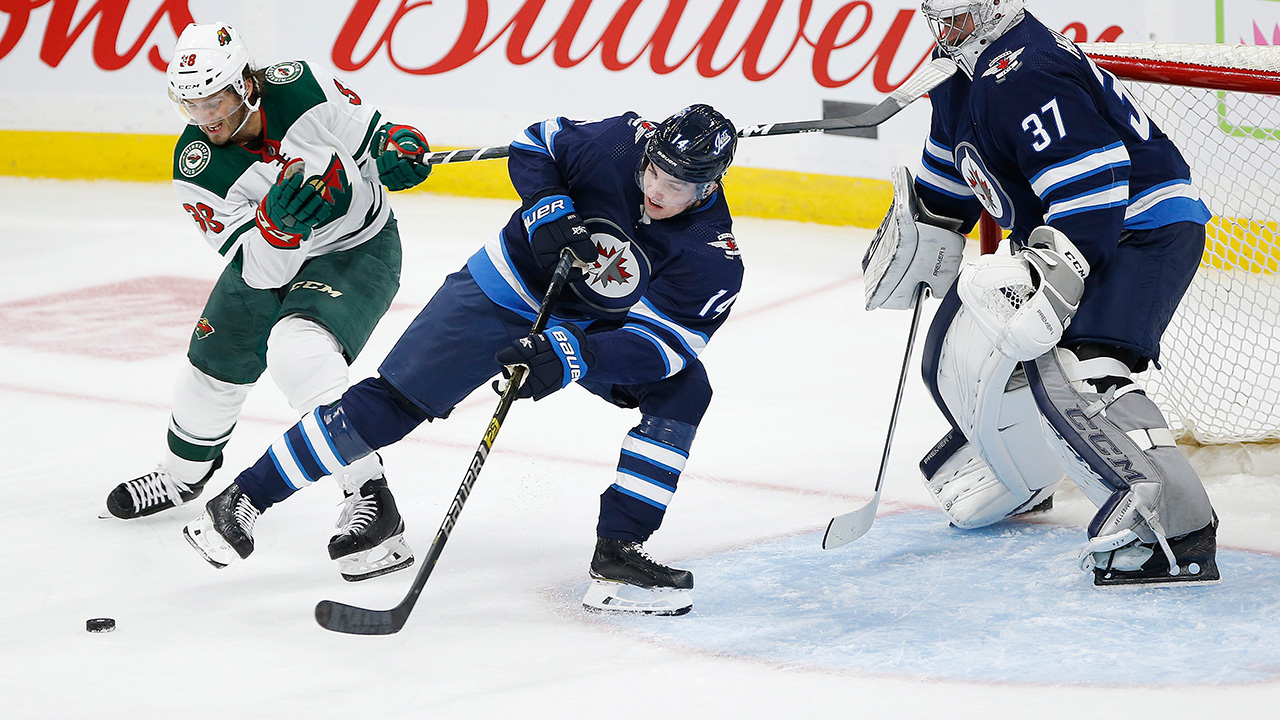Go get a house — you’re staying for a while.
That was Buffalo Sabres general manager Jason Botterill’s message to rookie Victor Olofsson earlier this month, as relayed by Sportsnet’s Chris Johnston during a recent Headlines segment on Hockey Night in Canada.
“Those are the words every rookie on the bubble wants to hear,” said Johnston.
Those are the words more rookies will hear in the coming days as many of the league’s newest additions, several of whom earned a roster spot out of training camp, now carve out a more permanent position on the roster.
In the case of Olofsson, who has been a revelation in Buffalo and is a big part of the club’s rousing success 10 games into the season, the decision to keep him in the big league doesn’t affect his contract structure. Because the rookie didn’t sign his entry-level deal until April 2018 at age 23, he’s already one year into a two-year ELC despite playing just six games last season.
For a number of other (younger) rookies, the 10-game milestone plays a big role in whether they stick in the NHL and develop on the biggest stage or get sent down to their junior club or AHL affiliate. This edition of the bi-weekly Rookie Notebook focuses on those players eligible for an Entry-Level Slide.
First off, here’s the official rule as outlined by the fine folks over at CapFriendly:
[blockquote]If a player who is signed to an entry-level contract and is 18 or 19 years of age (as of September 15 of the signing year), does not play in a minimum of 10 NHL games (including both regular season and playoffs; AHL games do not count), their contract is considered to ‘slide’, or extend, by one year. For example, if a player signed an ELC for three seasons from 2015-16 to 2017-2018, and their contract slides, their contract is now effective from 2016-17 to 2018-19. An exception to this rule is that if the player is 19 on September 15 of the first year of their contract, and turns 20 between September 16 and December 31, their contract does not slide. [cite]– CapFriendly.com[/cite][/blockquote]
Now, let’s dig in with a look at this year’s rookie class.
Who are some prominent rookies not eligible for an entry-level slide?
The Vegas Golden Knights slid rookie Cody Glass’s ELC slid two years already, making him ineligible for another (meaning that regardless of whether he sticks with the NHL club this season or not, his ELC has kicked in). Vegas also slid Erik Brannstrom’s contract two years before trading him to the Ottawa Senators, where he’s digging into the first year of his contract.
Montreal Canadiens rearguard Cale Fleury is also exempt from the ELS — he signed his ELC at age 20, which means that despite spending the 2018-19 season with the AHL’s Laval Rocket, he still burned the first year of his ELC.
Colorado Avalanche youngster Cale Makar signed as a 20-year-old last spring before jumping into the playoffs, so he’s already one year into his ELC — that’s also the case for Quinn Hughes of the Vancouver Canucks, who inked his first NHL deal last March before finishing the year with in the pros.
Who’s already been sent down?
Three players eligible for an ELS have already been sent down to their NHL clubs’ AHL affiliates before approaching 10 games: Maple Leafs defenceman Rasmus Sandin (Marlies), Kings defenceman Tobias Björnfot (Ontario Reign), and Capitals defenceman Martin Fehérváry (Hershey Bears). Nothing is stopping the clubs from re-calling them later this season, but it’s typical of rearguards to spend a little more time developing in the minors than their offensive-minded peers.
Now, for those still currently on an NHL roster…
Who should find themselves an apartment, and who might want to keep that suitcase handy? Here’s a list of ELS-eligible rookies currently with their NHL clubs and where they stand ahead of the all-important 10-game mark:
Ville Heinola, D, Winnipeg Jets
Games played: 8
Heinola, 18, might be the most intriguing case on this list. The Finnish defenceman came up big for the depleted Winnipeg Jets to start the season, and even scored a historic goal.
Despite his early impact in the Jets’ time of need, Heinola was a healthy scratch for three straight games. He has since returned to the lineup, making it clear the Jets simply need a longer look at the slight blue liner who’s learning on the fly early in the season. Dustin Byfuglien’s continued absence from the club while he ponders his future, in addition to the team’s off-season moves on the blue line, could make Heinola indispensable.
Jack Hughes, C, New Jersey Devils
Games played: 8
Because sports so often write the best scripts, it just so happened that Hughes scored his first career NHL goal against his big brother, Quinn, as the New Jersey Devils hosted the Vancouver Canucks on Saturday with several other members of the Hughes family in the stands to watch the matchup. (Quinn wasn’t on the ice for the goal, instead watching his little bro’s goal from the bench — wouldn’t that have been something?)
While not exactly lighting up the scoreboard — few are on the slow-starting Devils squad, really — Hughes has been playing like he very much belongs in the big leagues. You could argue that a year in the AHL would benefit the speedy centreman, but the No. 1 pick is right were he needs to be in order to continue progressing into the No. 1 centreman the Devils know they’ve got in him.
Kaapo Kakko, RW, New York Rangers
Games played: 7
Like Hughes, Kakko has been slow to produce at the NHL level. But also like Hughes, his first NHL marker (scored on Oct. 12 against the Edmonton Oilers) was really pretty:
Point production counts for a lot, but it isn’t everything — especially when you’re new to the league. Rangers head coach David Quinn told reporters over the weekend that he’s looking for more defensively-responsible play from the 18-year-old and has shifted Kakko around the lineup to expose him to different combinations. A strong off-season made many of us forget that this is still a developing team, and Kakko’s progress is part of that.
Noah Dobson, D, New York Islanders
Games played: 2
The P.E.I. native cracked the NHL roster out of camp and got an assist in his NHL debut, but hasn’t played since Oct. 11 having spent most of his time with the Islanders as a healthy scratch.
David Gustafsson, C, Winnipeg Jets
Games played: 4
An injury to Mark Letestu cleared a spot for Gustafsson on the fourth line after starting the season as a healthy scratch with the NHL club, but he has yet to play much more than six minutes in a game. The Jets preached patience out of the gate with him upon drafting him in the second round in 2018, with the forward spending the 2018-19 campaign playing pro in Sweden.
Oliver Wahlstrom, RW, New York Islanders
Games played: 3
Wahlstrom, 19, started the season with the Islanders’ AHL affiliate in Bridgeport but got the NHL call just 10 days into the campaign when an injury to Casey Cizikas opened up a spot for the 2018 first-round pick (he was selected just one spot ahead of teammate Dobson that year).
Islanders Twitter loves this kid, and it’s easy to see why. Though he’s been held off the scoresheet so far, Wahlstrom has been playing like a veteran and poses a versatile scoring threat with six shots in three games so far while even seeing a little bit of first-line time. If he doesn’t stick this time, it looks like it won’t be long before he does.
Barrett Hayton, C, Arizona Coyotes
Games played: 2
This one’s a tricky case. Hayton spent last year as captain of the OHL’s Sault Ste. Marie Greyhounds and should he not stick with the Coyotes, that’s where he’ll return as he’s not eligible to play in the AHL due to the CHL-NHL agreement. The 19-year-old, who could play a major role on Team Canada’s World Junior entry this year depending on how Arizona proceeds with him, posted 26 goals and 66 points in 39 OHL games last year… but is that the best place for him to take his game to the next level this year? He’s close to being an NHLer, and only time — or perhaps an injury among the current group of forwards — will tell if he’s slotted into the lineup to stay.
Kirby Dach, C, Chicago Blackhawks
Games played: 2
Wait, if Hayton can’t play in the AHL, why could Dach? The Blackhawks were able to assign the 19-year-old Dach, who was drafted third overall this past June out of the WHL’s Saskatoon Blades, to a conditioning stint of up to 14 days after recovering from a concussion suffered during pre-season. Turns out, his AHL stint lasted just three games before getting the NHL call-up to make his debut.
The 2019 third-overall pick was in the right place at the right time Tuesday night to score his first career NHL goal, and based on the Blackhawks’ current setup with their biggest stars still in their prime, that right-place-right-time logic could also be the reason he stays.
Should he not stick with the NHL club, he’ll be sent back to the Blades.
Joel Farabee, LW, Philadelphia Flyers
Games played: 1
Farabee was this close to making the NHL roster out of training camp, but wound up being the final cut ahead of the season. A four-game, four-point stint with the AHL’s Phantoms was enough for Flyers brass to edit the roster and bring the 19-year-old Boston University product back into the fold ahead of Monday’s game.
[relatedlinks]









